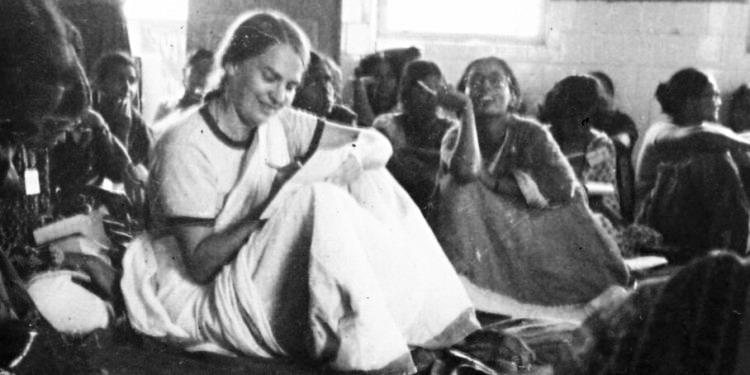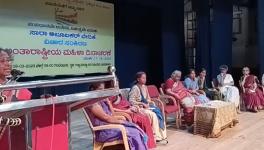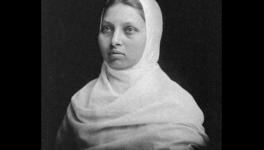Insurgent, Passional Chronicles of Revolutionary Praxis: Celebrating Gail Omvedt (1941-2021)

Image courtesy The Anand Market
What is ‘revolution’? How might we understand its social character, its histories and trajectories? How might we recognise revolutionaries and revolutionary action? What is the relationship between action and theory in the conceptualisation of the idea of revolution? What are the signposts of revolutionary utopias? What are its material, sociohistorical, and spatiotemporal contexts? How do revolutionary solidarities evolve – and what is the place of deliberative dialogue, contentious debate and disagreement in the forging of larger, more encompassing revolutionary solidarities? Questions on the inner worlds of revolution that straddle her very early writing on women’s struggles and feminist action in the 1970s (Omvedt 1975a, 1975b, 1980, 1990) and her writing on anti-caste philosophies, politics and movements well into the second decade of the 2000s animate Gail Omvedt’s work.
Reading her writing as it emerged in different contexts over five decades gave us a sense of her deep immersion as an interlocutor of mass struggles and the shifts in her position in relation to the larger debates on specific questions at specific historical moments – feminism, struggles for land and water, ecological struggles, against Hindu majoritarianism, among others. Revisiting her corpus now, sitting as we are in the belly of an ascendant Hindu supremacist regime, opens out the stunning power of her insurgent, passional chronicles of revolutionary praxis that journeyed through social and historical contexts in search of meaning, purpose and exemplars that will help us combat our troubled present in India today.
Reading her writing as it emerged in different contexts over five decades gave us a sense of her deep immersion as an interlocutor of mass struggles and the shifts in her position in relation to the larger debates on specific questions at specific historical moments.
Dalit resistance to caste rooted in material and spiritual contexts hold the key to understanding the history and possibilities of revolutionary praxis (Omvedt 2011). From her constructive critique of urban autonomous feminism, to her incessant, multiple threads of interrogation of Marxist frameworks to understand India, to her chronicling of the resistance to Hinduism on the Indian subcontinent – it is this that renders Indian history intelligible: the ways in which Dalits, bahujans, adivasis, peasants, workers, primarily rural, mostly women, fought untiringly for equality and dignity through struggles for land and water, against untouchability, for fair wages, for access to places of worship, and to natural resources (Omvedt 1993); the pathways to spirituality, belonging and a higher purpose crafted from below by dalit people that is materially rooted and not mediated by Brahmanical Hinduism (Omvedt 2003); and importantly, the anti-caste interrogation of the state – ruling class nexus at different historical moments (Omvedt 2014).
In mapping revolutionary praxis – indeed revolution itself – Omvedt presents congregations of the exemplars: Buddha, Kabir, Ravidas, Tukoba, Jotiba Phule, Iyothee Thass, Periyar, Ramabai, Ambedkar, and traces the multiple cadences of ‘enlightenment’ on the subcontinent that represented a philosophical cascade that surpassed the European Enlightenment that followed (Omvedt 2008a). The ideals of liberty, equality and fraternity in the Indian imaginary that she posited, were ideals liberated from the thralldom of caste, and visions that could be traced back historically to the emergence of Buddhism connecting it to the birth of Navayana led by Dr. Ambedkar (see especially Omvedt 2004, 2008b) and through literature, performance and the crafting of protest in unprecedented ways.
Even while mathri, conviviality, is the pivot of the anti-caste imagination, the struggle for the annihilation of caste and an equalitarian social order is one that resists violence and dispossession – everyday, routine and exceptional structural violence, and systemic and systematic dispossession along intersecting axes. In confronting violence and attempting to break the fetters that annihilate the oppressed castes, their politics of organising reveals complex intersections between movements, ideologies and politics as lived. There are crossings, intersections, silos, rigidities and fluidities that enhance or curtail the possibilities of social movements. In her insurgent accounts of the various sites of movement politics, Omvedt opens out to view the stunning yet fraught nature of these debates. In Reinventing Revolution (1993) for instance, she looks at the discrete struggles and the continuities between Naxalbari, Dalit Panthers, farmers’ movements, women’s movements, and ecological movements. In observing these movements from the inside, as an activist deeply invested in their gains and losses on the ground, Omvedt simultaneously embarks on a heuristic project of bridging the theoretical divide between the theory and the practice of resistance, entering into intense academic debates on Marxism, the mode of production, women’s liberation, and the distinction between ‘peasant’, agricultural labourer and farmer, for instance – dwelling on the centrality of lived experience to theory (Omvedt 1993).
The ideals of liberty, equality and fraternity in the Indian imaginary that she posited, were ideals liberated from the thralldom of caste, and visions that could be traced back historically to the emergence of Buddhism connecting it to the birth of Navayana led by Dr. Ambedkar and through literature, performance and the crafting of protest in unprecedented ways.
Take for instance her use of the term “‘peasant’ movements”:
‘Some prefer to call it a “farmers” movement rather than one of “peasants,” on the grounds that the term peasant refers to a more traditional, subsistence-oriented cultivator as contrasted with the more modem market-oriented farmer. But no such distinction can be made in Indian languages, which speak only of kisan, raitu, Khedut, shetkari, etc., and the fact remains that whatever the spread of market forces and the changing orientation of the Indian peasants, they continue to have their social and historical roots in a tradition that has persisted for thousands of years. Therefore I have continued to use the term “peasant”’ (Omvedt 1988: 14, n.1).
Or her recognition that ‘[r]ural and toiling women’s struggles occurred in many places, but they did not always yield a feminist articulation’ (Omvedt 1993: 84); her description of Ramabai and Tarabai Shinde as ‘early feminists’ who struggled against patriarchy (Omvedt 2011); and her use of ‘sexual terrorism’ to describe the (anticipation of) violence that curtailed women’s physical mobility (1993: 86), a term used later by feminist philosopher Cheris Kramarae (in Foss et.al. 1999: 47).
In studying social movements, and tracing their genealogies to utopian imaginations, Omvedt, a feminist with an unswerving Dalit Bahujan standpoint, traced the layered ways in which contemporary political formations understood, elided or accommodated/integrated women’s oppression, feudal regimes and caste into their articulations of politics and their critiques of power – particularly in her critical assessments of the left in India (1985), Satyashodhak Communist Party led by Sharad Patil and Shetkari Sanghatana led by Sharad Joshi (1993), and her foundational role in Shramik Mukti Dal. The fact that women were the drivers of mass struggle was empirically indefeasible, acknowledged by men in these movements: ‘time and time again male organisers of various Left parties testified to the fact that “women were the most militant”’ (Omvedt 1978: 371). Partha Mukherjee describes a major confrontation in Naxalbari in 1967 after two women and a policeman died the previous day:
‘One such village meeting was scheduled to be held in Prosadujote, largely at the initiative of the womenfolk who reacted sharply to the death of two women the previous evening. At this juncture the SDO’s police party was confronted by a babble of screaming women abusing them in unspeakable language… The overall impression one gets is that the police insisted on going ahead and the women insisted on their returning back, fearing that otherwise their menfolk would be arrested’ (quoted in Omvedt 1993: 51).
Of the ten people who died, seven were women. Gail Omvedt observes, ‘[t]he militancy of women (by the 1980s Mukherjee’s description of them shouting at their oppressors as “babble” would have been targeted as male chauvinism) thus played a significant part in the historic Indian revolt’ (ibid).
Sharad Patil added ‘ending women’s slavery’ to his Satyashodhak Communist Party’s goal of ending caste as indispensable to a democratic revolution, with property rights and sexuality being core concerns (1993: 102). The 1986 Chandwad conference organised by Shetkari Sanghatana under the leadership of Sharad Joshi reverberated with the slogan: ‘stri shakticya jagranat stri-purush mukti —the liberation of women and men through the awakening of women’s power’ (1993: 188). In the Shramik Mukti Dal (SMD) that Omvedt co-founded with Bharat Patankar, their perspective on women was ahead of any other left party. By Omvedt’s account, unless the struggle for a classless, casteless society free of women’s oppression was achieved, women would remain exploited. The SMD therefore focused on all the three liberatory aspects for the overall liberation of humanity’ (Gaikwad and Patil 2017). Importantly, within SMD, the movement of parityakta women (abandoned, divorced/deserted) from rural/small town-based groups cascaded into demands on the state for economic support and social legitimation for women to live outside the family (Omvedt 1990: 39).
While this was a time that also witnessed the autonomous women’s movement and feminism on the ascendant in India, Omvedt reiterates through all her accounts that the revolutionary cascade was constituted by Dalit Bahujan Adivasi women and absorbed in significant measure an intersectional feminist sensibility that was rooted in their lifeworlds even as it held lessons for movements worldwide. In her words, ‘…women in movements of agricultural and poor peasantry did not simply come forward as disembodied representatives of a class’ (Omvedt 1975b: 44).
Intersections and Convivial Praxis
Through all her published work, Gail Omvedt names co-travelers with whom she has agreed, disagreed, and collaborated with – to varying degrees. She provides a counterpoint to reductionist readings of Dalit struggles and to rural women’s militancy with respect especially to land and water – looking from drought prone Marathwada outwards. Over five decades, from the late 1960s till about 2017, she looked for ways of understanding Western theory in relation to Dalit Bahujan revolutionary praxis, and the ways in which they reinvented the idea of revolution; she looked closely at left and Marxist political formations in India in an attempt to understand the reasons for the theory-practice divide that she found so glaring. She searched for the meanings of the Dalit quest for insurgent spirituality.
In her intense engagements with political, literary and academic publics within and outside India, Gail Omvedt saw herself as an interlocutor, a messenger who carried forth the message of the annihilation of caste and the vision of the Dalit Bahujan revolution as the exemplar of revolution.
In their recent work on intersectionality, sociologists Patricia Hill Collins and Sirma Bilge (2016) trace the emergence of the concept to the early articulations of the interlocked oppressions of race, gender and class in the United States as also to Savitribai Phule’s articulation of caste and gender in the late nineteenth century – extending the work of Kimberle Crenshaw (1991) geographically and historically. Writing in the 1970s and 1980s, closely familiar with African American feminist struggles and with Dalit movements, Omvedt’s work in India in fact presages Crenshaw’s work in the US, focusing as it does on the interlocking oppressions of caste, gender and violence against women. While she references several Western feminist scholars in her work (Omvedt 1986, 1987, for instance) – she does not engage with the concept of intersectionality in her work, despite the praxiological overlap. By the early 1990s when Crenshaw wrote, Omvedt had shifted quite substantively to questions of rural struggles, agrarian crises, and anti-caste philosophies – where she continued to observe women’s engagement in resistance, but was less involved in international feminist debates. Yet, her work offers rich possibilities for scholars interested in the genealogies of intersectionality and their relevance in understanding Dalit Bahujan women’s radicalism. So also the case with the articulations of decolonial imaginations that challenge power at every site – in India particularly, the colonising juggernaut of Hindutva.
We also have debates globally today on the Second Convivialist Manifesto proposed by Convivialist International (2020). Built on five principles aimed at securing ‘mastery against excessiveness and hubris’: common nature, common humanity, common sociality, legitimate individuation, and creative opposition, the ‘declaration of interdependence’ sets out the normative theoretical position for human cooperation, solidarity, equal human dignity and the ‘necessity of its social realisation’ (convivialism) as well as its ‘lived praxis’ (conviviality) (Adloff 2019; Calle 2020). In her work (published and political), conviviality – maithri – has been at the centre of Gail Omvedt’s universe. This is a concept that has its roots in anti-caste philosophies and Dalit Bahujan Adivasi revolutionary praxis. Engaging with the futures of the convivialist manifesto from this vantage point therefore may yield important insights into organising against the rise of right wing nationalism and politics in India and internationally.
In her intense engagements with political, literary and academic publics within and outside India, Gail Omvedt saw herself as an interlocutor, a messenger who carried forth the message of the annihilation of caste and the vision of the Dalit Bahujan revolution as the exemplar of revolution.
References Cited:
A. Gail Omvedt
____. 1975a. ‘Caste, class and women’s liberation in India.’ Bulletin of Concerned Asian Scholars, 7:1, 43-48, DOI: 10.1080/14672715.1975.10406361.
____. 1975b. ‘Rural origins of women’s liberation in India.’ Social Scientist, Vol. 4, No. 4/5, Special Number on Women (Nov. – Dec., 1975), pp. 40-54.
____. 1978. Women and rural revolt in India, The Journal of Peasant Studies, 5:3, 370-403.
____. 1980. We Will Smash This Prison: Indian Women in Struggle. London: Zed Books.
____. 1985. ‘The left in India.’ Journal of Contemporary Asia, 15:2, 172-182, DOI: 10.1080/00472338580000111.
____. 1986. Omvedt, G. (1986). “Patriarchy:” The analysis of women’s oppression. Insurgent Sociologist, 13(3), 30–50. doi:10.1177/089692058601300305. Accessed on 31 August 2021.
____. 1987. ‘The creation of patriarchy.’ Economic and Political Weekly, 31 October 1987, pp. WS 70-WS 72.
____. 1988. ‘The “New peasant movement” in India, Bulletin of Concerned Asian Scholars, 20:2, 14-23, DOI: 10.1080/14672715.1988.10404445.
____. 1990. Violence Against Women: New Movements and New Theories in India, New Delhi: Kali for Women.
____. 1993. Reinventing Revolution: New Social Movements and the Socialist Tradition in India, New York: ME Sharpe Inc. 1993.
____. 2003. Buddhism in India: Challenging Brahmanism and Caste. New Delhi: Sage.
____. 2004. ‘Liberty, equality, community: Dr. Ambedkar’s vision for a new social order’. Fourth Dr. Ambedkar Memorial Annual Lecture, Jawaharlal Nehru University (Delivered in 2000).
____. 2008a. Seeking Begumpura: The Social Vision of Anti-Caste Intellectuals. New Delhi: Navayana.
____. 2008b. Ambedkar: Towards and Enlightened India. New Delhi: Penguin Books.
____. 2011. Understanding Caste: From Buddha to Ambedkar and Beyond, Hyderabad: Orient BlackSwan.
____. 2014. Dalits and the Democratic Revolution: Dr. Ambedkar and the Dalit Movement in Colonial India. New Delhi: Sage.
B. Other Works
- Adloff, Frank. 2019. Practices of Conviviality and the Social and Political Theory of Convivialism
- Conviviality Dossier. Novos estud. CEBRAP, São Paulo, V38, No. 01: 35-47, Jan.– Apr. 2019. https://www.scielo.br/j/nec/a/NbV3MKBtx79NR5CKjQvxgbR/?lang=en Accessed on 3 July 2021.
- Collins, Patricia Hill and Sirma Bilge, 2016. Intersectionality. Cambridge: Polity Press.
- Convivialist International, ‘The Second Convivialist Manifesto: Towards a Post-Neoliberal World,’ Civic Sociology, 16 June 2020.
- https://online.ucpress.edu/cs/article/1/1/12721/112920/THE-SECOND-CONVI… Accessed on 29 June 2021.
- Crenshaw, Kimberle Williams (1991) Mapping the margins: Intersectionality, identity politics, and violence against women of color. Stanford Law Review. 43: 1241-99.
- Foss, Karen A., Sonja K. Foss and Cindy L. Griffin. 1998. “Cheris Kramarae” In Feminist Rhetorical Theories. Thousand Oaks, London & New Delhi: Sage. Pp. 33-68.
- B.N. Gaikwad and Sumeet R. Patil. 2017. Interview with Dr Gail Omvedt. Writers in Conversation, Vol. 4 no. 2, August.
Kalpana Kannabiran is an advocate, sociologist and human rights columnist based in Secunderabad, Telangana.
Disclaimer: The views expressed in this article are the writer's own, and do not necessarily represent the views of the Indian Writers' Forum.
Get the latest reports & analysis with people's perspective on Protests, movements & deep analytical videos, discussions of the current affairs in your Telegram app. Subscribe to NewsClick's Telegram channel & get Real-Time updates on stories, as they get published on our website.
























